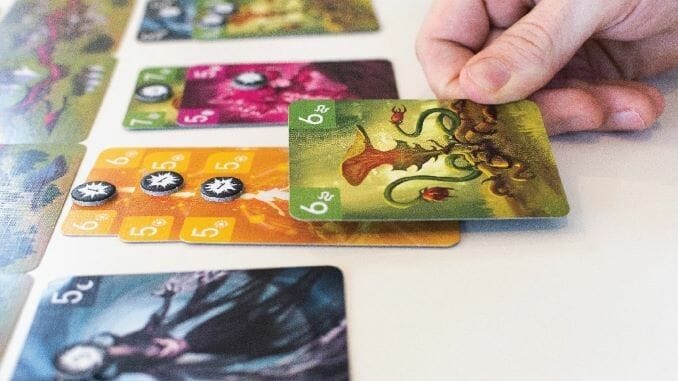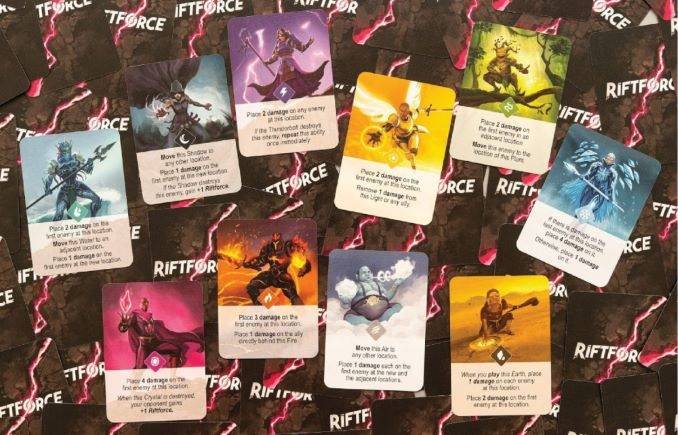Riftforce Checks All the Boxes for a Good Two-Player Card Game
Photos courtesy of Capstone Games Games Reviews board games
Riftforce, a new two-player game from designer Carlo Bortolini (Memoarrr!), is what you might get if you smashed together the capture-the-flag game Battle Line, where two players play cards to each of nine flags between them to try to capture them with the stronger set, with Magic: the Gathering. Like Magic, in this game the cards have powers that change your strategy—and also mean your opponent can blow your cards right off the table.
The Riftforce deck comprises 10 colors, each of which is supposed to represent an “elemental,” such as fire, air, water, the usual suspects, with cards of values 5, 6, and 7. Each player builds a deck with just four of those 10 colors, which you can determine with a draft, or just create at random by shuffling the 10 reference cards for the colors and dealing four to each player. Players draw hands of seven cards to begin the game, and will then take one of three actions on each turn as they battle over five neutral cards lined up in between them.
Two of the actions involve the cards themselves. The first lets you play up to three cards of the same color or number; you may play them all to one location, or play one card each to two or three adjacent locations. (The frequency of powers that refer to adjacent locations means that the left- and right-most ones require slightly different tactics than the three in the middle.) The second lets you activate up to three cards of the same color or the same number, but to do so, you must discard a card from your hand of that color/number. You then use the power of each card’s color, which usually involves adding 1 to 4 points of damage to your opponent’s card nearest the center. Once a card has accumulated damage equal to or greater than its face value, it is destroyed and removed from the game, earning the destroying player one Riftforce (victory point).

The third action lets you replenish your hand in a way that, timed well, can earn you more points. You do not draw cards after each turn, so eventually you will have to take a turn to refill your hand up to seven cards. When you do so, you also “check,” by which you gain one victory point for each of the five locations where you have at least one card but your opponent has none. You may gain multiple points, but your opponent doesn’t gain points when you check, even if they have cards at locations where you have none. Thus timing your check-and-draw actions is more strategic than in games like Century Spice Road, where you just use up all your cards and pick your hand back up because you’ve run out of things to do.
You can also gain extra points from certain colors—the Shadow (light grey) suit isn’t very powerful, adding just one point of damage to an opponent’s card, but if that is the fatal blow, you get an extra point for the kill. The Crystal (magenta) cards drop 4 damage when they’re activated, but if you destroy one, you get an extra Riftforce. Play continues until one player reaches 12 Riftforce, after which the game either ends immediately or the other player gets one last turn to ensure both players have had the same number of plays. You may exceed 12 points, of course, and the player with the most points wins, regardless of any situation on the table.
Riftforce offers huge replay value because of the number of suits in the game—there are 210 unique combinations of four colors you can draw from the 10 in the game, and 3150 possible combinations of two sets of four. It also seems tailor-made for expansions that add a couple of additional suits with new powers. After a couple of plays, I’m not sure if the Sun (yellow) cards are too strong, as they drop 2 damage on an opponent and let you remove 1 damage from any card on your side of the table, regardless of its location, so if you activate three Sun cards in a turn, you can remove 3 damage and potentially stave off a loss or two. The aforementioned Shadow suit and the Air suit both seem a little underpowered, although it may be that they just require more targeted use that I’ll see with further plays.
Two-player games are always in demand, and the best of them involve some kind of direct interaction—you don’t want to be playing simultaneous solitaire—while also creating enough variety that you’ll feel like playing it again and again with the same partner. I also think two-player games are best if they’re portable, games you can throw in a bag or a suitcase for a trip or just keep handy (as opposed to big-box games that take up so much space you have to create a whole separate section in your basement just to house them … I mean, hypothetically). Riftforce checks all of these boxes: It’s replayable, the interaction is constant, it’s in a small box and could easily be carried without it, since it’s just a large deck of cards and some damage point tokens. And it hits the right combination of fun and strategy, as with Battle Line, Jaipur, or the similar Air Land & Sea. If you’ve liked those games, Riftforce hits most of the same high points. Just don’t be surprised when your wife enjoys blowing up your cards a little more than you expected.
Keith Law is the author of The Inside Game and Smart Baseball and a senior baseball writer for The Athletic. You can find his personal blog the dish, covering games, literature, and more, at meadowparty.com/blog.